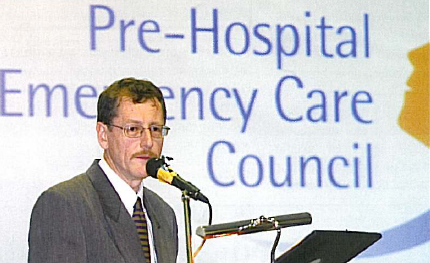Introduction to the Minister
Address by Professor Gerard Bury. Vice Chair of the Pre-Hospital Emergency Care Council.
The immediate availability of an ambulance in a medical emergency is probably the most fundamental health service response which the public expects. Until today, that ambulance has been crewed by Emergency Medical Technicians or EMTs who are trained and equipped to provide effective care and safe transport to the Emergency Department for definitive treatment. With today's historic initiative, the ambulance service response to that emergency will be significantly enhanced.
To date EMTs have been limited in what they can do to assist the patient. The first ever review of the Ambulance Services was conducted in 1993. This was a far reaching report that laid the fou nd ations for radical change in the field of pre-hospital emergency care. Hardly a year has passed since then that the Ambulance Service haven't been mentioned in strategic reports on the health service. Examples include the National Health Strategy, the Cardiovascular Strategy, the Value for Money audit and the CEOs Review published in 2002.
A key recommendation contained in the '93 Report was the introduction of advanced prehospital emergency care; that recommendation finally becomes a reality today. Advanced care in the Irish setting will now be provided by an Emergency Medical Technician-Advanced or EMT-A. The EMT-A in the Irish health service will be a practitioner with appropriate training, authorised to use wide-ranging Advanced Clinical Practice Guidelines. The EMT-A is the equivalent of the familiar para medic in other jurisdictions such as the US or UK. With the launch of an EMT-A programme, the public can expect and will receive advanced pre-hospital care, on a par with the best standards anywhere in the world.
The EMT-A programme has progressed through many phases; it has the support of medical, nursing and Ambulance Service authorities from all parts of Ireland. Advanced care will bring the potential to prevent deaths and complications of illness or injury and to minimise pain and suffering. With the advent of the EMT-A, the ambulance service acquires the capacity to bring advanced medical care beyond the walls of the Emergency Department into the public domain and communities where we live.
The foundation stone of all good emergency care is the provision of excellent basic life support; in Ireland we are fortunate that our existing EMTs have been trained to ensure that this key element has become widely established. We now move to a new phase of professional development. EMT-As will be trained and licensed to extend the BLS baseline to advanced airway management techniques, to administer medication in medical emergencies such as asthma, diabetes or epilepsy and to manage cardiac arrest victims. The evidence based Advanced Clinical Practice Guidelines approved by the PHECC will introduce standards of care comparable with any service worldwide.
|
|
The EMT-A initiative must be seen in the wider context of reform of Irish health services. Radical developments are occurring in the Irish healthcare sector. The National Health Strategy, out-of-hours GP cooperatives and proposed changes in Emergency Department services are just three of many influences on the ambulance service of the future. The ambulance services and EMTs and EMT-As have crucial roles to play in providing a wide range of care services such as emergency responses, tiered responses, bypass capability and inter-hospital transfers.
With the availability of advanced training and skills, the capacity to transfer care seamlessly between pre-hospital and acute hospital services and between acute and tertiary referral hospitals can be achieved. All of these developments have the potential to serve our patients more effectively and to improve the likelihood of a good outcome.
The demands of advanced training are often seen as principally being about the use of complex technology or the administration of drugs with dramatic effects; this view can be deceptive. While competence and confidence in the use of technologies and administration of drugs will be required of each EMT-A, the personal qualities which these practitioners bring to their professional roles are among the most important contributions they will make. The ability to interact calmly with distressed patients, to gather, interpret and analyse key pieces of information, to make informed clinical decisions, to identify options for intervention and to make the correct choice for the patient are the key attributes of the thinking, caring professional. We depend on the skilled, committed and well-trained EMT-As of the future to use their training, experience, judgement and clinical reasoning skills to select and administer the care most appropriate to the patient's needs.
The Pre-Hospital Emergency Care Council will work with the Irish ambulance services, the recognised training bodies and principally candidate EMT-A's to translate today's decisions into the reality of improved emergency care on the ground.
To formally announce policy approval for the introduction of the EMT-A programme it gives me great pleasure to introduce Mr Micheal Martin TD, Minister for Health and Children.
|
 Professor Gerard Bury
Professor Gerard Bury